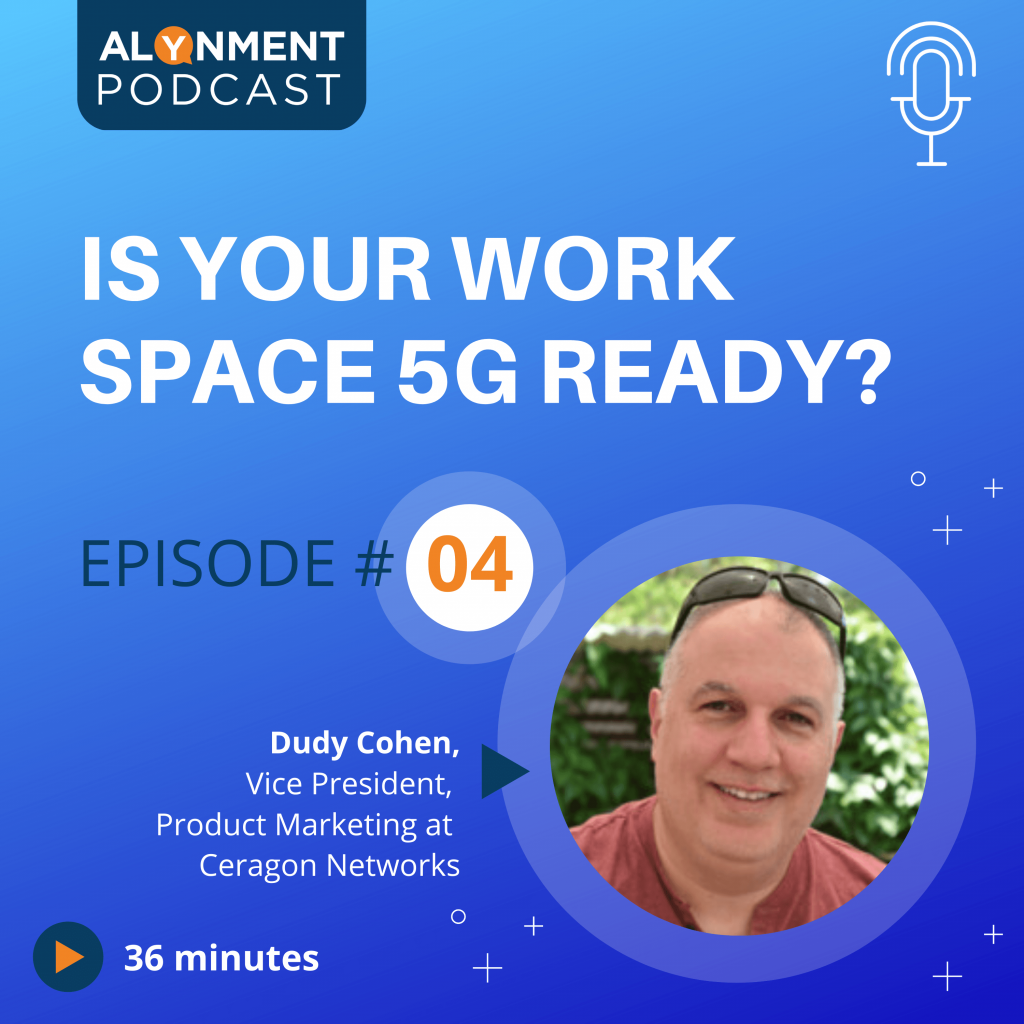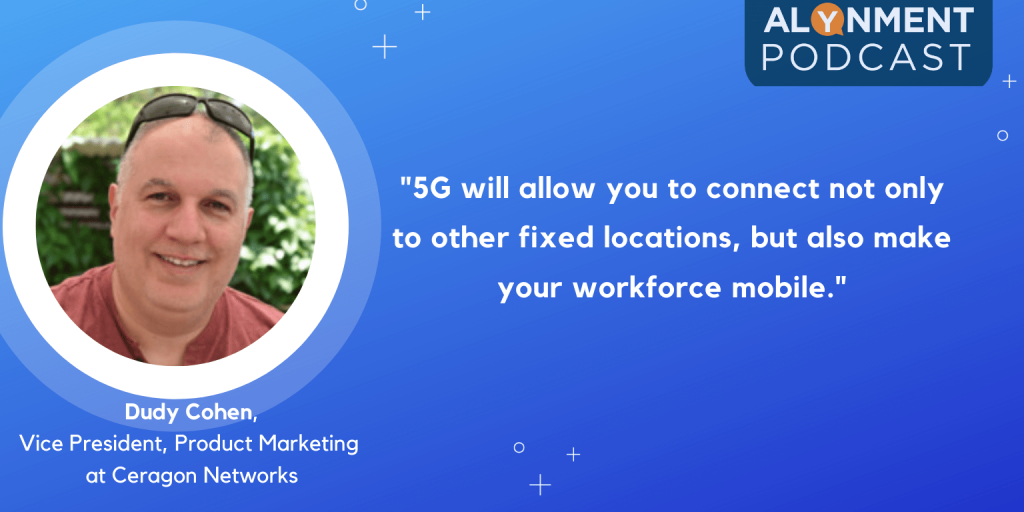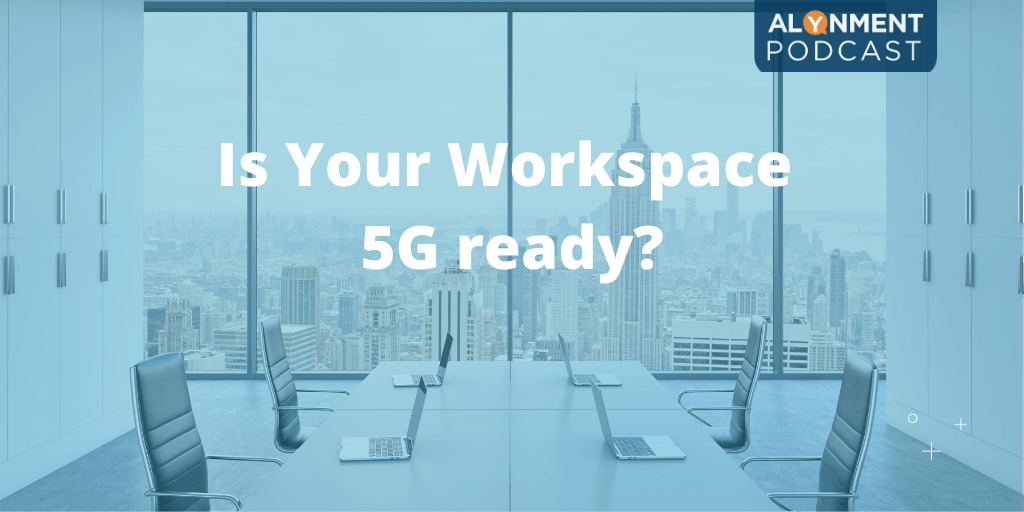5G, unlike other cellular generations, is touted to bring unprecedented innovation for enterprises more than we have ever seen before. But for that vision to become real, a lot of things need to be in place. While telecom service providers are getting all their ducks in a row, enterprises and building owners also need to align their plans to make their workspaces 5G ready. [Listen to the full conversation here]
Dudy Cohen, currently the Vice President of Product Marketing of Ceragon Networks has decades of experience in the telecom industry, both as a vendor as well as a service provider. While he understands 5G technology across the entire spectrum, he has experience in delivering enterprise communication and data applications as well.

HOW IS 5G GOING TO CHANGE THE OVERALL WIRELESS INFRASTRUCTURE EXPERIENCE?
5G is usually mentioned in the context of enhanced mobile broadband, which is only one use of the 5G promise. It’s practically more of the same to what we have in 4G because we’re talking about more capacity and more services over the existing devices, whether for consumers or enterprises. But 5G is much more than that. And the other applications of 5G are much more crucial for the business of enterprise or a small/medium business because they allow you to enhance productivity and to use the wireless network or the mobile network in manners you hadn’t had a chance to do before.
So 5G is on top of the enhanced mobile broadband, which is commonly discussed also provides an option for fixed wireless access, meaning that if you sit in your enterprise office and want ultra-Broadband, you want a one gig symmetrical connectivity to accommodate all the important traffic you have towards the world, you do not have to wait or to engage with an operator that will arrive at your premise with fiber. 5G technology allows getting those very high capacities wirelessly.
5G will allow you to connect not only to other fixed locations but also make your workforce mobile. And to create stuff like a mobile office, imagine an infrastructure that will allow your staff to be connected to the office in terms of capacity and in terms of latency from wherever they can. They can do it today in some places in the U.S. In such a case, you are more productive, as you can work from anywhere that there’s no point for you to commute to work each and every day.
WHAT DO ENTERPRISES NEED TO HAVE IN PLACE FOR THE 5G VISION TO BECOME REAL?
There are a couple of things that the enterprise or an organization and individuals within it should do to be ready to fully utilize the opportunity that 5G brings. For a very simple example, 5G will now be an option for WAN connectivity. So on top of lining your SD-WAN strategy with 5G and because now, you will have more endpoints to connect to. There will be mobile endpoints, so you need to understand how to connect your main data center or main headquarter to other branches and the cloud providers, now you also want to connect those to any number of additional endpoints that represent either your employees or additional data sources, if you are a business that can leverage some IoT development. So this is one approach and something you need to bear in mind because 5G will change or evolve the way your enterprise network would look like.
On the more practical physical level 5G will allow you to connect branches or even the headquarter with wireless, so you need to be ready. There may be equipment on the roof or the need to get cabling from different locations than what you do today with fiber or copper from an ISP. It might also be worth considering having an operator put a base station or small cell just outsider your premise to give you the coverage you need for your premise.
You also need a mindset that is aware of and open to disruptive technologies and disruptive business models. Be ready to change the way you do business with your connectivity provider – 5G brings opportunities for new types of providers, like Dish in US and Rakuten in Japan that are new operators with new models and new services. So keep an open mind in how you get the best solution for your connectivity.

CAN 5G BECOME PRIMARY WAN LINK FOR BUSINESSES?
Yes. Because it is true that today in the 4G and the previous generation, we tend to see the wireless or mobile connectivity as a not very reliable or application-aware method of connectivity. This changes in 5G due to the new radio technology that become a viable solution for mission-critical applications. 5G is targeting two additional very important applications in addition to eMBB. MMTC, which is massive machine type communication, basically, IoT, and URLLC, that is an ultra, reliable low-latency communication, which are applications that require ultra-reliability and little latency. The 5G RAN- Radio Access Network – was updated with capabilities that allow it to be aware of the applications running over it and to have dedicated resources and quality of service for different applications. This notion is usually referred to as Network Slicing. Network slicing is a fancy name for VPN, which means that they took our infrastructure end to end and sliced it into dedicated slices for use by different types of applications. So if you have a real-time application like a video conference, or if you have remote control of machinery in industrial application, then you need very low latency and very high-reliability solution, and you will get your services on the specific network slice that is dedicated for it. So basically a Netflix binge could not interfere with your video conference.
This capability is not only embedded in the core but also in the NR radio protocols, which means it provides end-to-end control of the quality of service and network slicing is right up to the end device. This is the main reason that makes 5G valid and in some cases a leading solution both in terms of the essence of the service and in terms of cost-efficiency. 5G is an opportunity for mobile operators to become much more dominant suppliers to enterprises and any other type of customer who requires the best effort solution.
HOW IS 5G DIFFERENT FROM ITS PREVIOUS GENERATIONS IN PLANNING FOR CELLULAR COVERAGE IN OUTDOOR AND INDOOR CAPACITY?
There’s a debate lately that 5G will kill WiFi. And this is too strong of a statement because 5G with all these capabilities, is an amazing technology that can provide a lot of new services and in much more capacity. I don’t think it’s the optimal way to do the LAN connectivity within your organization, to do indoor coverage within your campus. It might be a bit early to skip the stage in which you plan your WiFi coverage. WiFi is gaining ground with the introduction of Wi-Fi 6 and my observation is Wi-Fi 6 is a complementary solution for 5G and not a competitive solution for 5G.
If the spectrum used for mobile coverage in LTE and LTE Advanced and the LTE Advanced PRO is, let’s say up to 2 and 1/2 gigahertz, usually for indoor coverage, you’ll use less than 1 gigahertz. In 5G, to get those high capacities and to provide those gigabit connectivity services, mobile operators need to use much higher bands, and it can range up to 24 gigahertz and more. And due to propagation issues, this is a very hard spectrum to penetrate the building. You should consider giving room to small cells or femtocells or other 5G network options, and I think there will be a migration from DAS, distributed antenna systems, to active small cells, which will play a major role in outdoor and indoor coverage.
The enterprises will benefit from cooperating with the operators. This is the main consideration when it comes to 5G readiness in your physical buildings.
HOW IMPORTANT IS THE FIBRE INFRASTRUCTURE WITHIN THE BUILDING AS WELL AS COMING FROM OUTSIDE?
The move to higher frequencies and wider channels is providing access to speeds that rival fiber. If you want to connect your enterprise to a network, to another enterprise or campus to a data center that is not very far, you can do this using wireless technology that can provide you point to point connectivity of 20 Gbps. 5G can connect end devices and enterprise, with rates of 1 GBPS. So, 5G does not require you to be connected to fiber to leverage the benefits of it. It allows a lot of location to be now connected to broadband, even though they do not have fiber connectivity available.
This is great news for enterprises that rely heavily on their connectivity. The more you move your business functions and IT functions to the cloud and anything of the service, the more you’re reliant on your WAN connectivity, and your business continuity is dependent on, reliable WAN connectivity. And you want to invest in this connectivity because it’s crucial for your business. 5G poses a great opportunity in this matter.
HOW DO WE BRING IN CELLULAR OR WIRELESS CONNECTIVITY INSIDE A BUILDING?
In the new era of 5G, CBRS and other opportunities for non-operators to bring services to themselves or other customers, enterprises have a lot more options to resolve their challenges on their own or with help from new players, not necessarily the mobile operators. Indeed the high-frequency millimeter wave used for bringing this high capacity poses a challenge of your indoor coverage and there are few early developments in making this a reality. But at the end of the day, we cannot break physics, and this high spectrum is very hard to work indoors.
There are complementary solutions like the evolution of DAS, the usage of CBRS for indoor coverage, these small cells from different types of operators and the bottom line is that there are more options. 5G brings disruptions for many areas and many angles of the telecom industry in terms of technology disruption and there are more business models. There are a lot more options for operators to build a network today compared to what they had in 4G also in terms of business models. There are a lot more players who can now take parts of 5G technology and take spectrum, which was in the sole domain of operators, bundle this approach into a new kind of offering either for self-use or to sell it to the enterprises from a different angle, and enterprises will see a lot of providers in an atypical position as they approach them with new offerings. And this is why they need to keep a very open mind-set, with regards to what they do with whom.
The evolution that is happening needs to happen. 5G is going to be successful in a more collaborative way. Up until now, these technologies had their delineations in terms of who is providing that service and what role an enterprise play in it. With 5G they will have to play a much more active role in implementing those technologies within their premise, to be successful with it. They cannot be just relying on the public infrastructure that is out there. There’s a lot of more options for them and they can very well personalize and customize the way they intend to use this technology for their applications.
I think this is a very exciting time for both, the organizations that come into a new position and use this new technology and for the consumers because, at the end of the day, we need to remember that everything is done to promote the business of the enterprise and the small-medium business. This new world will bring opportunities to promote the business and enterprise that will hook into this opportunity and will know how to leverage these unique capabilities that might find themselves in a very good competitive position and cost structure compared to what they are now and compared to an organization that will not leverage those opportunities.
I think we truly demystified 5G for enterprise professionals who may understand the promise of this technology but are not sure where to begin when it comes to its execution. I believe we have a way now.
That was the fourth episode one of our Alynment podcast series – where we align the “what” with the “how” and “why.” I hope this conversation gave you a realistic perspective on the impact of emerging 5G and augmented reality technologies will have on businesses and our everyday lives.
Take a moment to subscribe to the podcast, so we keep providing you with exciting conversations and real-world stories straight to your inbox. Send in your suggestions, questions, and feedback to me at [email protected] or reach me on Linkedin. Thanks again Dudy, for speaking to us.


